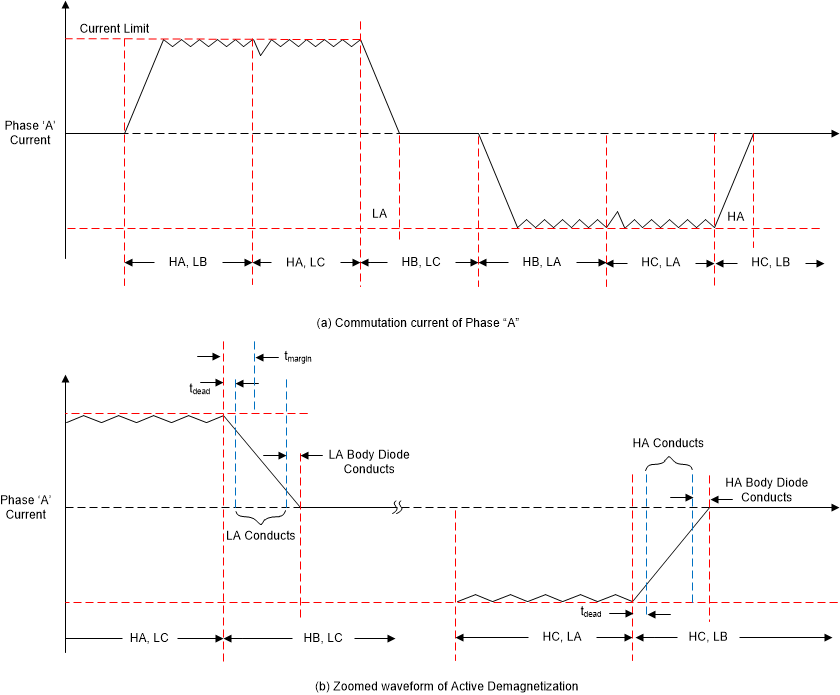JAJSNT0A december 2022 – april 2023 MCT8315A
PRODUCTION DATA
- 1
- 1 特長
- 2 アプリケーション
- 3 概要
- 4 Revision History
- 5 Pin Configuration and Functions
- 6 Specifications
-
7 Detailed Description
- 7.1 Overview
- 7.2 Functional Block Diagram
- 7.3
Feature Description
- 7.3.1 Output Stage
- 7.3.2 Device Interface
- 7.3.3 Step-Down Mixed-Mode Buck Regulator
- 7.3.4 AVDD Linear Voltage Regulator
- 7.3.5 Charge Pump
- 7.3.6 Slew Rate Control
- 7.3.7 Cross Conduction (Dead Time)
- 7.3.8 Speed Control
- 7.3.9 Starting the Motor Under Different Initial Conditions
- 7.3.10 Motor Start Sequence (MSS)
- 7.3.11 Closed Loop Operation
- 7.3.12 Speed Loop
- 7.3.13 Input Power Regulation
- 7.3.14 Anti-Voltage Surge (AVS)
- 7.3.15 Output PWM Switching Frequency
- 7.3.16 Fast Start-up (< 50 ms)
- 7.3.17 Fast Deceleration
- 7.3.18 Active Demagnetization
- 7.3.19 Motor Stop Options
- 7.3.20 FG Configuration
- 7.3.21
Protections
- 7.3.21.1 VM Supply Undervoltage Lockout
- 7.3.21.2 AVDD Undervoltage Lockout (AVDD_UV)
- 7.3.21.3 BUCK Undervoltage Lockout (BUCK_UV)
- 7.3.21.4 VCP Charge Pump Undervoltage Lockout (CPUV)
- 7.3.21.5 Overvoltage Protection (OVP)
- 7.3.21.6 Overcurrent Protection (OCP)
- 7.3.21.7 Buck Overcurrent Protection
- 7.3.21.8
Cycle-by-Cycle (CBC) Current Limit (CBC_ILIMIT)
- 7.3.21.8.1 CBC_ILIMIT Automatic Recovery next PWM Cycle (CBC_ILIMIT_MODE = 000xb)
- 7.3.21.8.2 CBC_ILIMIT Automatic Recovery Threshold Based (CBC_ILIMIT_MODE = 001xb)
- 7.3.21.8.3 CBC_ILIMIT Automatic Recovery after 'n' PWM Cycles (CBC_ILIMIT_MODE = 010xb)
- 7.3.21.8.4 CBC_ILIMIT Report Only (CBC_ILIMIT_MODE = 0110b)
- 7.3.21.8.5 CBC_ILIMIT Disabled (CBC_ILIMIT_MODE = 0111b or 1xxxb)
- 7.3.21.9 Lock Detection Current Limit (LOCK_ILIMIT)
- 7.3.21.10 Thermal Warning (OTW)
- 7.3.21.11 Thermal Shutdown (TSD)
- 7.3.21.12 Motor Lock (MTR_LCK)
- 7.3.21.13 Motor Lock Detection
- 7.3.21.14 SW VM Undervoltage Protection
- 7.3.21.15 SW VM Overvoltage Protection
- 7.3.21.16 IPD Faults
- 7.4 Device Functional Modes
- 7.5 External Interface
- 7.6 EEPROM access and I2C interface
- 7.7 EEPROM (Non-Volatile) Register Map
- 7.8 RAM (Volatile) Register Map
- 8 Application and Implementation
- 9 Power Supply Recommendations
- 10Layout
- 11Device and Documentation Support
- 12Mechanical, Packaging, and Orderable Information
パッケージ・オプション
メカニカル・データ(パッケージ|ピン)
- RGF|40
サーマルパッド・メカニカル・データ
- RGF|40
発注情報
7.3.18.1 Active Demagnetization in action
Figure 7-40 shows the operation of active demagnetization during the BLDC motor commutation. As shown in Figure 7-40 (a), the current is flowing from HA to LC in one commutation state. During the commutation change over as shown in Figure 7-40 (b), the HB FET is turned ON (and HA FET is turned OFF), and the commutation current (due to motor inductance) in OUTA flows through the body diode of LA. This results in a higher diode loss depending on the commutation current. This commutation loss is reduced by turning on the LA FET for the commutation time as shown in Figure 7-40 (c).
Similarly, the active demagnetization operation of a high-side FET is realized in Figure 7-40 (d), (e) and (f).
 Figure 7-40 Active Demagnetization in BLDC Motor
Commutation
Figure 7-40 Active Demagnetization in BLDC Motor
CommutationFigure 7-41 (a) shows the BLDC motor phase current waveforms with Active Demagnetization with trapezoidal commutation. This figure shows the operation of various switches in a single commutation cycle.
Figure 7-41 (b) shows the zoomed waveform of commutation cycle.
 Figure 7-41 Current Waveforms with Active
Demagnetization
Figure 7-41 Current Waveforms with Active
Demagnetization